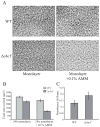Identification of novel stage-specific genetic requirements through whole genome transcription profiling of Vibrio cholerae biofilm development
- PMID: 16135229
- PMCID: PMC2600799
- DOI: 10.1111/j.1365-2958.2005.04797.x
Identification of novel stage-specific genetic requirements through whole genome transcription profiling of Vibrio cholerae biofilm development
Abstract
Bacterial biofilm formation has been described as a developmental process. This process may be divided into three stages: the planktonic stage, the monolayer stage and the biofilm stage. Bacteria in the planktonic stage are not attached to each other or to a surface; bacteria in the monolayer stage are attached to surfaces as single cells; and bacteria in the biofilm stage are attached to surfaces as cellular aggregates. In a study limited to the Vibrio cholerae flaA, mshA and vps genes, we previously demonstrated that transcription in monolayer cells is distinct from that in biofilm cells and that the genetic requirements of monolayer formation are distinct from those of biofilm formation. In this work, we sought to identify additional stage-specific genetic requirements through microarray analysis of the V. cholerae transcriptome during biofilm development. These studies demonstrated unique patterns of transcription in the planktonic, monolayer and biofilm stages of biofilm development. Based on our microarray results, we selected cheY-3 as well as two previously uncharacterized genes, bap1 and leuO, for targeted mutation. The DeltacheY-3 mutant displayed a defect in monolayer but not biofilm formation, suggesting that chemotaxis plays a stage-specific role in formation of the V. cholerae monolayer. Mutants carrying deletions in bap1 and leuO formed monolayers that were indistinguishable from those formed by wild-type V. cholerae. In contrast, these mutants displayed greatly decreased biofilm accumulation. Our microarray analyses document modulation of the transcriptome of V. cholerae as it progresses through the stages in biofilm development. These studies demonstrate that microarray analysis of the transcriptome of biofilm development may greatly accelerate the discovery of novel targets for stage-specific inhibition of biofilm development.
Figures





References
-
- Baneres JL, Roquet F, Martin A, Parello J. A minimized human integrin alpha(5)beta(1) that retains ligand recognition. J Biol Chem. 2000;275:5888–5903. - PubMed
-
- Carroll PA, Tashima KT, Rogers MB, DiRita VJ, Calderwood SB. Phase variation in tcpH modulates expression of the ToxR regulon in Vibrio cholerae. Mol Microbiol. 1997;25:1099–1111. - PubMed
-
- Colwell RR, Huq A. Environmental reservoir of Vibrio cholerae. The causative agent of cholera. Ann N Y Acad Sci. 1994;740:44–54. - PubMed
Publication types
MeSH terms
Substances
Grants and funding
LinkOut - more resources
Full Text Sources
Other Literature Sources

